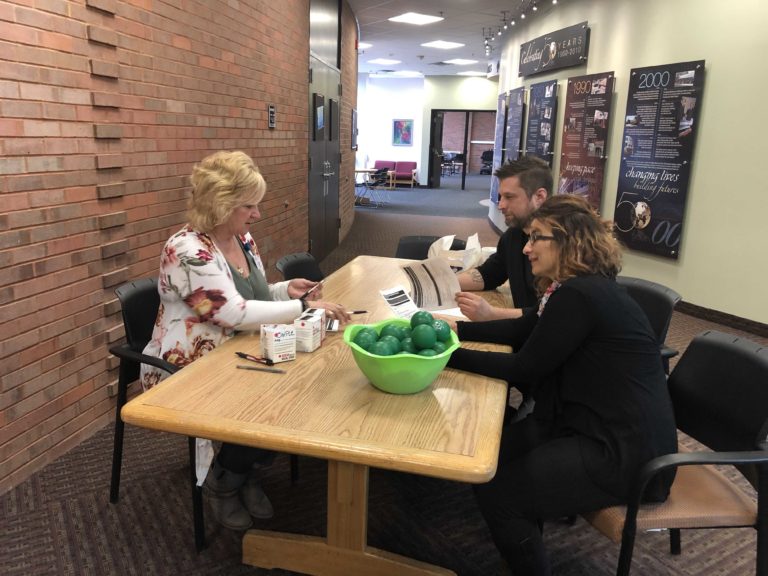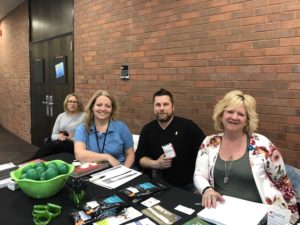Creating Awareness of the Opioid Crisis in Stark County
by StarkStatePTK · March 28, 2019

Andrea Young – Webmaster, Vice President Ohio Region
Students at Stark State main campus learned about service and programs related to drug overdose and recovery services available in Stark county. Representatives from the Stark Health Department, CommQuest, and Project Dawn visited the main campus in the Atrium to educate, and create an awareness to the resources available.
Julie Priebe, RN, who serves as an Addiction Recovery Nurse Navigator and SOS Quick Response Nurse at CommQuest, spoke with students about the signs and symptoms of an individual in an emergency overdose situation. She noted that there are many different at-risk people with a varied range of demographics.
The table was stocked with literature on prevention tips, substance abuse identification guides, as well as a list of agencies and their respective contact information. Several students took advantage of the training on administering the prescription drug Narcan to an individual who has overdosed. While Narcan is a prescription medication, it is available at agencies like Project Dawn and the Health Department as well as at local pharmacies without a prescription. Students at the event could receive training on how to use the medication as well as the the medication Narcan.
Priebe highlighted the Stark County and Mental Health & Addiction Recovery’s (Stark MAHR) monthly meetings that include representatives from the Opioid Task Force, the Health Department, ReCor, Commquest Services as well as other community organizations and local community members who address the issues. She highlighted the opportunity for students to help their local community share ideas and help with the prevention of overdose deaths in our county. Meetings are held the third Friday of every month from 11:30-1pm and meets at 121 Cleveland Avenue South in Canton.
Michelle Schoonover, RN of the Stark County Health Department also gave training and information on proper disposal of needles and administering Narcan.
Elizabeth Inkinen Schehl, Student Support at Stark State, was encouraged by the students who attended and received the timely information. “It is so important to get this information out to the community and our students. Equipping those around us with valuable training and information is the key to saving lives,” she said.
Recent History on Stark County's Drug Overdoses
According to Priebe, Stark County has seen some improvements in the past several years due to the public awareness and resources available:
2016: –Stark County saw the highest death rate due to overdose with a death toll around 118.
The rate of deaths jumped to a higher rate due to the introduction of Fentanyl in heroin supplies. Fentanyl made heroin 50-100 times more potent with users unaware that it was in the supply.
“Most heroin addicts are at a point where they do not get a high anymore, so they were overdosing as a result of the addition of fentynal.”
Priebe explained that the health department and agencies had fentynal strips available for addicts to test their supplies.
Once in a while, Prieb noted, they will see carfentanil, which is not meant for human consumption as it is a elephant/large animal tranquilizer.
“Just a grain the size of sand could kill a human,” she said.
2018– the death toll fell to 72 which they believe is a direct result of the help in the form of Narcan, peer support task force and local agencies coming together to educate on overdoses. From utilizing harm reduction strategies to recovery services, there are several options available to those who are struggling with addiction.
A Student's Perspective:

Brian Melio – Vice President Elect
The set up was an outstanding opportunity that enhanced my personal awareness of the opiate crisis. Not only did I learn how the crisis is specifically affecting Stark County, but I learned what Stark is doing to relieve all the symptoms of the crisis. From door to door teams, to personal counseling, and providing peer-peer support by individuals recovering from prescription and other opiate addictions. The broad-spectrum approach that Stark County has invested in overcoming is nothing short of impressive and hopeful. But that isn’t the bottom-line solution. I learned the value of what I can do to help. That was the most impressive take-away for me. It’s our community and “TOGETHER” is where the real change and impact happens. I was made aware of the many way I can contribute. At the display I was able to take my first step of action by receiving a Narcan kit with training right there.
My next step of action will be to join one of the many teams that go out into the community once a month and visit people whom have suffered an opiate crisis event in their lives and let them know we are hear for them. There are many other ways we can all help. It is our goal along with all these other organizations and people to help uplift others. There was a great deal of passion at that table and it was motivating help to make a difference.
Brian Melio, PTK; SHIMA; Health Information Management; Executive Chef, Sparta Steakhouse & Lounge
Recent Posts
- Catalyst International Convention 2024
- Beta Gamma Epsilon Featured in the SSC Snapshot
- Ohio Region Awards 2024
- Ohio Region Leadership In Action 2023
- Chapter President Tammy Monroe Featured on the Stark State Website
- Ohio Region Honors In Action Conference 2023
- Meet Randy Shipman!
- Congratulations PTK Graduating Class of 2023!
- Stark State Spring Fling 2023
- Catalyst 2023!


